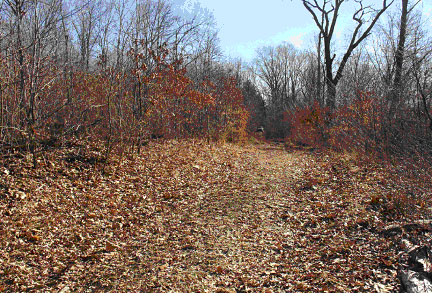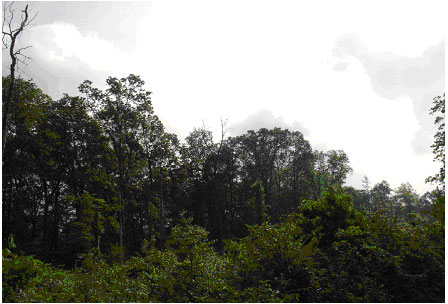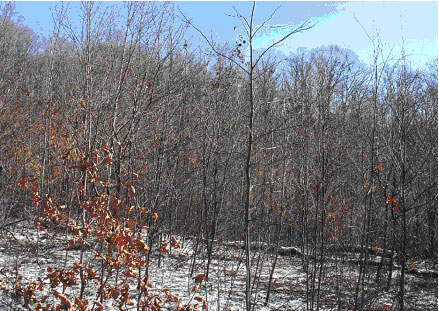Regeneration Cutting on Private Woodlands –
Is It For You?
By John Stambaugh
Historically, surveys of those who own woodlands show they do so for a host of reasons. As a forester and woodland owner I am always curious about what these trends are telling us. Today the surveys show that we place very high emphasis on matters relating to wildlife and biodiversity. In fact, protecting wildlife habitat, viewing wildlife, and offering biodiversity rank among the top reasons people own woodlands.
Most woodland owners realize how vital habitat diversity is to our native wildlife, but we have also come to understand how important it is to our own health, contentment, and prosperity (clean air, water, and recreation). This was not the case during the settlement period in Indiana’s history. Up until the beginning of the past century, the habitat we cherish now – wetlands, bogs, swamps, prairies, and forests comprised of massive trees – were considered obstructions to progress. The flood of settlers needed fields and pasture to survive – not habitat. So they cleared the great forests, drained the wetlands (4.79 million acres in Indiana alone), and extirpated much of the wildlife from the landscape. In time, however, during the Great Depression descendants of the settlers were driven from vast regions of those lands due to infertile soils from years of abuse.
Today we know better. We have a much greater understanding of conservation and our dependence on healthy, diverse landscapes. Great strides have been made during the ensuing decades by foresters, other natural resource professionals, and impassioned citizens to mitigate these mistakes through valuable conservation efforts. During this time of recovery our forests reclaimed large segments of their former domain, but in the process have developed to the point where we now have an abundance of mid-mature to mature forest types and a shortage of very young forests. Why is this important?
Young, early successional habitat is vital for a host of native wildlife species including ruffed grouse, woodcock, many migratory songbirds (for example, Eastern Towhee, Yellow-breasted Chat, American Redstart, Bell’s Vireo, and Blue-winged Warbler), cottontail rabbit, bats, Lepidoptera (moths and butterflies), a host of small mammals, and reptiles. Research suggests that young forests benefit mature forest birds by providing food sources for fledglings those important for building up fat reserves prior to migration.
Where You Come In
So what can private woodland owners do to create this vital habitat on their land?
There are many factors that are specific to your property to consider when answering this question. Therefore, the first step is to seek the assistance of a professional forester to help guide you in the planning process.
In those landowner surveys, managing woodlands to sustain the health and vigor of the timber resource is also a priority to landowners. When conducting forestry practices, including planned sales and timber harvests, using the advice of your professional forester is crucial to maintaining your woodland’s health and productive capacity. For example, professional foresters have helped many landowners oversee harvests on woods impacted by Emerald Ash Borer or injury from the 2012 drought.
Like us, woodlands have a past, but each is unique. In their case, this depends on who owned them, past uses and abuses, and the frequency and intensity of historical natural disturbances. Consequently, the management needs of each stand can vary widely. Once your forester has the opportunity to visit your land to view the current state of affairs, he or she may recommend some level of regeneration cutting in a specific area.
Regeneration Cutting as a Management Tool
Regeneration cutting is a tool, just like selective cutting, used to attain desired results. There are three types of regeneration cutting methods typically used in this region: Clearcutting, Shelterwood, and Seedtree. Depending on the method recommended by your forester, the process involves removing some or all the trees in certain regions for desired purposes.
Some of the conditions that could be present leading your forester to suggest regeneration cutting include:
1. Poor sites populated by trees struggling to develop
2. Over-mature or declining Oak/Hickory stands preferably with advanced regeneration (seedlings of desired species already present)
3. Stands with a history of being high-graded or abused
4. Regions where you want improved hunting and wildlife viewing
5. Softwood (pine) stands you wish to convert to native hardwoods
6. Sites that join older openings or field edges (improved biodiversity)
Following a regeneration harvest, by the end of that first growing season there is a remarkable flush of new growth in the form of annual, perennial weeds, tree and shrub seedlings, berries, and other flora due to the abundance of full sun. Larger openings expose more soil to the sun, and thus, create a large, diverse young forest. This process replicates historical disturbances that we now keep in check, and ultimately, is also beneficial for creating even-aged stands of high quality hardwood timber later.
Here are just some of the potential benefits of using regeneration cutting as a management tool in portions of your forest:
1. Create young, early-successional habitat
2. Increase biodiversity
3. Establish diverse stand ages and development classes
4. Improved recreation: hunting and wildlife viewing
5. Converts low quality, or under-producing stands to vigorous stands of higher productivity and health
6. Reduces harvest impacts and volume demand on remaining forest land
7. Isolates potential entry of invasive plants (limits disturbance to the openings)
8. Creates conditions for a superior stand of timber later
9. Improved logging efficiency
I am finding over time that more landowners are quite receptive to performing this practice on their land. Here are three examples of landowners using a regeneration harvest within their woodlands to achieve desired results.
Conclusion
Of course there are instances where a particular woodland has no need for regeneration cutting. The practice should only be used where it has a need on the landscape and also meets the objectives of the woodland owner.
When following the recommendations of your forester to use regeneration cutting as part of your woodland management program, you can greatly enhance the diversity of the habitat on your property to benefit wildlife, while at the same time improve the growing stock of your timber resource.
Note: Examples taken from Hefner Timber LLC and D & C Dodrill
John Stambaugh is a consultant forester with 25 years’ experience in Indiana. He is a board member of the Woodland Steward Institute, representing the Indiana Society of American Foresters.

Property A (Monroe Co.)
Pre-harvest condition
a. 4,900 bf/ac
b. South facing, poor, eroded clay site, Oak-Hickory, mixed with Red and Sugar maple, Ash, Tulip
c. Few trees over 20” dbh
d. Several selective cuts in the previous 30 years had left a stand of primarily lower grade, defective trees.
Landowner objectives.
a. Owner seeks productive, high quality stands
b. has an avid interest in creating more grouse habitat (early-successional habitat) on a property that presently has a dwindling grouse population
Harvest details
a. Cut in the fall of 2005
b. Grapple skidder used.
c. 7 ac opening created
d. TSI was performed following the harvest
e. Purposely left behind some large snags for wildlife
Post-harvest condition today
a. Heavily stocked with large sapling and post sized trees. High component of Oak and Hickory, plus Tulip, Cherry, and Ash.
b. Rapid growth continues

Property B (Greene Co.)
Pre-harvest condition
a. 10,800 bf/ac
b. Dominated by over-mature, deteriorating Black oak and Hickory growing on a slightly SE facing, severely eroded clay site.
c. Thin soils with rock outcroppings
d. Growth had slowed markedly
e. Heavy green briar understory. History of grazing
f. High component of advanced regeneration of oak-hickory
Landowner objectives
a. Reestablishing a productive, healthy stand.
b. Create diverse wildlife habitat
c. Improve hunting opportunity for hunters who pay for a lease
Harvest details
a. 4.3 ac opening
b. Cut in the Fall of 2010
c. TSI followed harvest
Post-harvest condition today
a. Strong oak-hickory regeneration
b. Joins mature forest for greater biodiversity

Property C (Greene Co.)
Pre-harvest condition
a. 9,700 bf/ac
a. Mature to over-mature White, Black Red oak and hickory. Included White oak veneer trees
c. West facing slope
Landowner objectives
a. Minimize amount of harvesting on remaining woodlands.
b. Receive timber income
c. Make the opening large enough to develop a viable replacement stand
d. Create early successional habitat
Harvest details
a. Cut in the fall of 2005
b. 3.5 acre opening
c. TSI followed the harvest
d. Some snags were left behind
Post-harvest condition today
a. Heavy Tulip, Cherry, Ash regeneration with an Oak-hickory component spread throughout
b. Mature forest surrounds opening, large creek 300’ away, tremendous biodiversity
